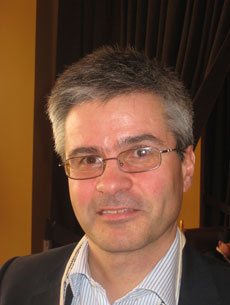CNS A Jewel In IATA Crown

 When
the International Air Transport Association (IATA) named Aleks Popovich
as its first Head of Global Cargo a couple of years back, it’s doubtful
that the unassuming executive who burst upon the world transportation
scene with a clear mandate for change, foresaw that one day he would have
to operate with his head in two places at once. When
the International Air Transport Association (IATA) named Aleks Popovich
as its first Head of Global Cargo a couple of years back, it’s doubtful
that the unassuming executive who burst upon the world transportation
scene with a clear mandate for change, foresaw that one day he would have
to operate with his head in two places at once.
But that is exactly what has happened.
After the widely reported resignation in
the U.S. of Cargo Network Services (CNS) President Jens Tubbesing, Mr.
Popovich is now Acting President of CNS, a post he will occupy until the
CNS Board meets this autumn and selects a new leader.
But when we caught up with him yesterday
working out of the conference room at IATA headquarters in Miami, Aleks
who is a hands-on guy with definite thoughts about almost everything,
sounded as if the two headed thing was no problem, and his tenure as CNS
President will be less acting and more business as usual, including a
host of initiatives that will continue to be set forward even during this
season of change.
“CNS is a tremendous resource, the
centerpiece of IATA Cargo.
“Everyone can believe that the best
test is through delivery.
“We are four square behind not only
the continuation of CNS, but also its development and growth as a beacon
for air cargo everywhere.
“Before I joined IATA, I looked at
what the organization had in terms of cargo assets.
“To my mind the greatest was and continues
to be CNS.
“In many ways, around the world, CNS
is also IATA’s best kept secret.
“Obviously we will work to change
that.
"The new CNS team in America is young
and energetic and absolutely first rate.
"Programs such as CASS, Cargo 2000,
E-Freight and last but not least the CNS Partnership Conference and its
initiatives are not only world class but the best on the planet.
“The process has started already to
find a new President in cooperation with the CNS Customer Advisory Board
made up of airlines, forwarders and ground handlers who we consult and
dialogue with and greatly rely upon.
“The need here is to get the right
person that takes CNS to the next level.
"The CNS President, in addition to
other responsibilities, will direct Cargo 2000, accountable to the Cargo
2000 Board, and will be charged with expanding the bandwidth of all activities
including implementing the CASS system into the U.S.
domestic market later this year.
"We also want to expand participation in
e-freight and Cargo 2000 by energizing the small and medium-sized air
freight companies in the USA by making the case that the CNS organization
is working for the betterment of air cargo, and involvement in the process
delivers the best hope for success all around.
"In future the possibilities for expanding
the CNS CASS system could also include the U.S. trucking industry.
“CNS is the jewel in the crown that
will grow in size and importance during the months and years ahead.”
Asked about priorities ahead for IATA Cargo
elsewhere, Aleks Popovich spoke of further implementation of global e-freight
as well as continued emphasis on the secure freight initiative, addressing
environmental challenges and more.
But to Mr. Popovich, a smart guy who at
times appears to have the ability to see around curves, dialogue, discovery,
reason and consensus are elements that will drive IATA Cargo in years
ahead.
“Next March
2-5 (dates just changed)
our Third
World Cargo Symposium (WCS) will take place in Bangkok at
Centara Grand at Central World Hotel Bangkok..
“Focus On The Customer—Delivering
The Goods In Turbulent Times,” will be the theme.
"The Third WCS event is about issues
and solutions.
"But our first presentation from IATA
Director General and CEO Bisignani will center upon promises made and
kept, or otherwise, at the Second Annual WCS that took place earlier this
year in Rome.
“IATA Cargo must stay relevant.
“Today the industry is challenged
as never before with runaway fuel costs causing pain all around with some
companies even going under.
“The situation demands that our agenda
be up front and relevant and allow for sharing success and shortcomings
with everyone.
“The way to change things is to involve
everyone.
“At WCS 2009, we plan to gather the
best and the brightest to carry forward issues and look for solutions
such as cost savings, as fuel continues to have huge impact.
"We will also continue to advance e-freight,
quality (Cargo 2000), safety, security and the green agenda.
“Our effort is a forward vision to
deliver the promise of air cargo by empowering the industry to greater
understanding and cooperation, step-by-step, one day at a time.”
popovicha@iata.org
Geoffrey
|




![]()
![]()
![]()
